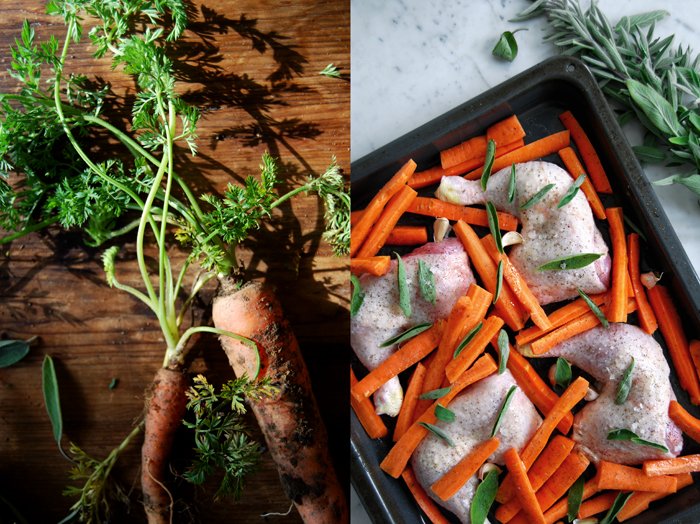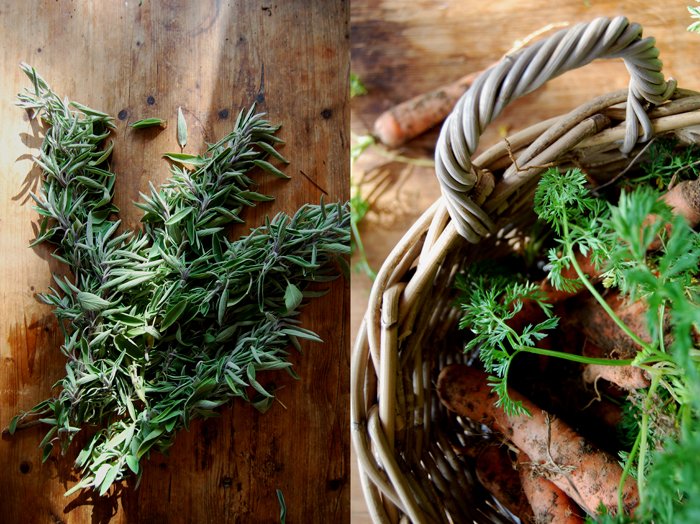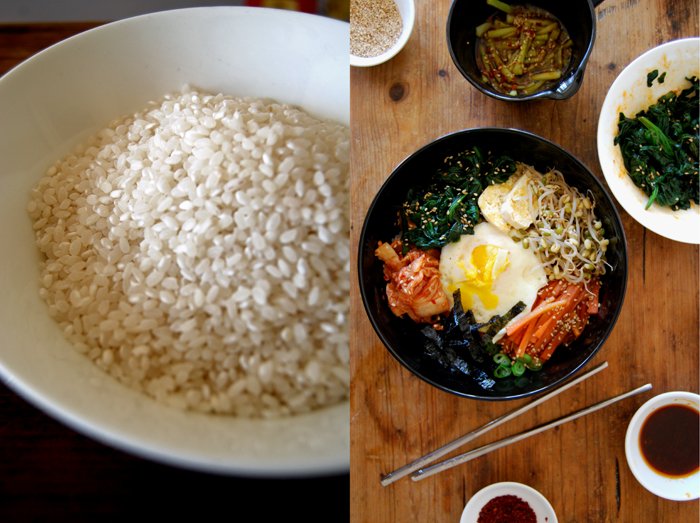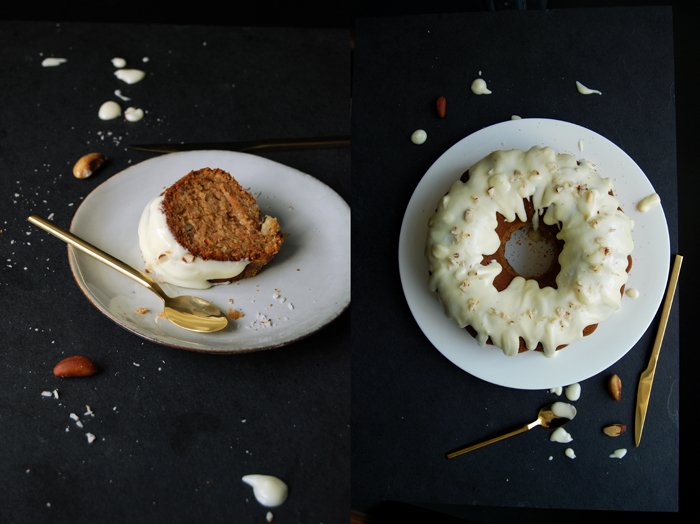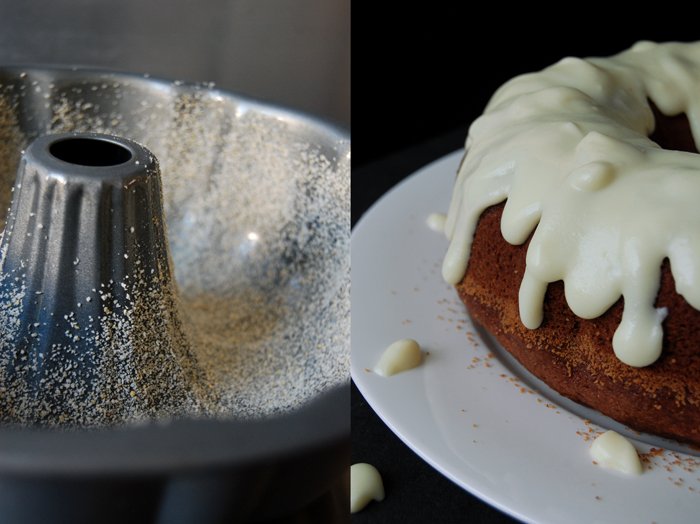Rosemary Butter Beans with Maple Roast Roots
I don't know why but this winter I didn't really get into the mood for cabbage. Give me beans, lentils, all kinds of legumes and I'm happy. And whenever I pulled roasted roots out of my oven I was almost ecstatic, but cabbage, unfortunately, left me a bit uninspired. This is quite unusual for me, I would sometimes cook it every week in big batches in the cold season, cauliflower, kale, red cabbage heads and savoy, my freezer was always full with leftovers from my various cabbage creations.
I believe that you should follow your taste, your gut feeling in life. Whatever your appetite calls for stands for something that your body needs at that moment, not only when it comes to food. Lets leave out the excessive consuming of chocolate and cakes, this doesn't count in my train of thought, that's more for the soul rather than for the body, which is as important. My appetite definitely calls for legumes and roots! There weren't many cabbage recipes on eat in my kitchen this winter, just three, my Ginger Lemon Ricotta stuffed Cabbage Rolls, Savoy Cabbage with Coriander and Maltese Sausage and the Christmassy Roasted Red Cabbage with Orange Wedges. Roots, beans and lentils, that's what I put into my pots and pans most of the time.
Today's recipe combines both, velvety butter beans cooked with rosemary and caramelized mixed roots roasted in the oven in sticky maple syrup olive oil. The carrots, beetroot and Navet roots (yellow turnip) were still a bit crunchy and just as good when they were cold. This was our energising snack together with yesterday's olive oil bundt cake while we remodeled the kitchen. This dish works as a warming meal or a rich salad, just prepare a bigger batch and enjoy it for days!
White Rosemary Beans and Maple Roast Roots
For 3-4 people you need
dried butter beans, soaked in lots of water overnight, 250g / 9 ounces
broth to cook the beans (or 1 carrot, 1/4 celery root and 1/4 leek)
fresh rosemary, a small bunch
Navet roots (yellow turnip), cut into wedges, 3 (or 1 small rutabaga, peeled)
medium beets, peeled and cut into wedges, 2
carrots, peeled, cut in half (lengthwise), 10
cloves of garlic, in their skin, 6
olive oil 6 tablespoons
maple syrup 1 tablespoon
balsamic vinegar 1 teaspoon
coarse sea salt and pepper
In a large pot, cook the beans in enough broth - or in water with the carrot (cut in half), celery (peeled) and leek (cut in half) - for about an hour, don't add any salt. Add a sprig of rosemary in the last 15 minutes. When the beans are done take them out with a slotted ladle and mix them with 1 tablespoon of olive oil, balsamic vinegar, salt and pepper. Season to taste.
Set the oven to 200°C / 390°F (I used the Rotitherm setting).
Whisk 5 tablespoons of olive oil with the maple syrup and pepper. Spread the Navet roots, beets, carrots and garlic in a large baking dish or on a tray and coat them with the maple oil, add a few sprigs of rosemary. Sprinkle the roots generously with coarse sea salt and roast in the oven for about 45 minutes or until golden brown and al dente, turning them every 15 minutes. Serve on top of the beans.
Honey glazed Chicken and Carrots roasted with Sage
A package filled to the brim with carrots and sage arrived at my door a couple days ago. I opened the box impatiently and when I lifted the cover a cloud of soil and sage aromas filled the room. I removed the top layer of sage leaves, closed my eyes and dug my hands into the greens of 6 pounds of carrots. It felt like standing on a field in the middle of a farm!
The box came from my mother's vegetable garden where she bas been busy with the annual spring chores. I envy her for the fertile patch of earth where she grows all kinds of vegetables in unbelievable quantities, potatoes, beans, carrots, peas, tomatoes, zucchini, leek, celery, lettuce and, of course lots of herbs. Whenever I ask her about her harvest, she tells me about so many different vegetables that I'm sure I forgot to list one or two. The area she chose for her gardening isn't large, it has a slight decline, perfectly aligned facing the South so it's in the the sun all day and the soil is very rich. A couple days ago she called me up to ask if I would like to have some of last year's carrots which had been in the soil all winter but had to make room for the new seeds. She dug pound after pound out of the soil (she was a bit impressed by the amount herself) and now she was looking for thankful recipients. I was glad to be one of them, I didn't even know that one can eat carrots which have been in the ground all winter. To keep them safe and moist on their travel she wrapped them in branches of sage which apparently grow like weeds in her garden. If there is one person who has a green thumb it's definitely my mother!
So the carrots arrived and I had to come up with an idea to use them, a recipe which demands lots of carrots. I didn't make roast chicken legs in a while so a quick decision was made, honey glazed chicken legs and carrots roasted with sage!
Honey glazed Chicken Legs and Carrots roasted with Sage
If you like you can marinate the chicken legs in the honey glaze for an hour (or longer) but season with salt and pepper just before you put them in the oven.
For 4 people you need
chicken legs 4
honey 2 tablespoons
olive oil 5 tablespoons plus a couple tablespoon for the carrots
large carrots, quartered lengthwise, 10
garlic, in their skin, 10 cloves
fresh sage leaves 30 (10 chopped)
salt and pepper
Set the oven to 200°C / 390°F. My oven has a Rotitherm roasting setting which works perfectly for poultry.
Warm the honey in a sauce pan on medium heat until liquid, take off the heat and add the olive oil, whisk till combined. Glaze the chicken legs on all sides with the honey and season with salt and pepper. Place on a baking sheet, add the carrots and garlic and spread the remaining honey over the chicken and vegetables. Pour some more olive oil over the carrots and season them with salt and pepper. Sprinkle with the sage (chopped and leaves) and put 2 of the leaves under each leg. Roast in the oven for 20 minutes or until golden brown. Check with a skewer, only clear juices should come out. Turn the grill on for a couple minutes until the skin starts sizzling and turns dark and crisp.
Yu-Kyong's Bibimbap, a traditional Korean treat
A few weeks ago I met a very sweet couple from Norway, Lena and Knut, we sat opposite each other at a supper club and started talking. Days later I found out about their wonderful blog Teak Tray Weekdays where they share little treasures of their daily life in Trondheim and their traveling trips, I got peacefully lost in their stories. When Lena asked me if I would like to cook something together with them I was very happy. I liked the idea of the three of us cooking the same meal in different kitchens in different countries and with different recipes. I let them choose what we would cook and they suggested Bibimbap. They had just been to Berlin and enjoyed this Korean speciality at a restaurant so much that they wanted to cook it at home.
At first, I wasn't sure about my approach to this meal. I had never cooked Korean before and I usually need an experience, a memory, a story, taste, something that opens the door to a new culinary experience. I asked my oldest friend Yu-Kyong for help, we lived next to each other through our whole childhood, she has Korean roots, her father grew up in North Korea and her mother in the South. She lived in Germany all her life but her mother cooks Korean for the family and introduced her daughter to the traditional recipes, like Bibimbap.
When I asked Yu-Kyong to write down the recipe so that I could buy all the ingredients she told me that this wouldn't work, we would have to go shopping together. We met at an Asian market and she gave me an introduction to Korean cooking. She explained the necessary spices, mixtures, spice pastes and preparations to me, all in between hundreds of boxes, tins and bottles of food, freezers stuffed with tiny crabs, octopus and fish. The scent of a different world in my nose, visually overwhelmed, I tried to keep up with her. She told me about the different flavours and qualities of sesame oil, I learnt how to cook sticky rice properly, which cutlery I have to use (a metal spoon and metal chopsticks, not wooden!) and so much more. Basically, a one hour crash course on Korean cooking, in the middle of an Asian market, typing everything more or less precisely into my phone, not to forget a single detail.
I got home with bags of vegetables, Kimchi, roasted seaweed, Obok Gochujang hot pepper paste, many colourful tins and boxes. I bought the first tofu of my life and I felt happy and finally prepared for this new cooking experience.
Here's a quick description of Bibimbap, it's a one pot meal, rice at the bottom and steamed vegetables mixed with a sesame oil and soy sauce dressing on top. I steamed spinach, sprouts and carrots and added strips of seaweed, Kimchi (spicy fermented cabbage), fried tofu and eggs. The spinach is glazed with the special Bibimbap Gochujang sauce which is mixed into the rice as well. I made a traditional cucumber salad on the side, mixed with sesame oil and soy sauce, sprinkled with chili powder and toasted sesame seeds.
This meal needs good preparation before you mix everything together, it's a ceremony of pure tastes mixed with the strong flavour of good quality sesame oil and the spiciness of Gochujang. When you make your own Bibimbap you should allow some extra time to enjoy the cutting, steaming and mixing, it's meditative. I learnt that this is not a warm meal, the rice and egg (which I fried in the end) have to be warm but the steamed vegetables can be cold.
Vegetable Bibimbap and Cucumber Salad
For 3-4 people you need
sticky rice, rinsed, 170g / 6 ounces
soybean sprouts, steamed for 1-2 minutes, a handful
spinach, steamed for 1-2 minutes, 250g / 9 ounces
carrot, cut into julienne, steamed for 1 minute, 1-2
tofu, cut into 0.5cm / 1/4" slices, 200g / 7 ounces
Kimchi 6 tablespoons
spring onions, cut into thin slices, a small handful
Korean roasted seaweed, cut into strips, 5 sheets
organic eggs 3-4
sesame seeds, toasted in a pan for a couple minutes on medium heat, 2 tablespoons
cucumber, peeled, cut in half, without the seeds and soft parts, a 15cm / 6" piece for the cucumber salad
dried chili spice for the cucumber salad, 1/8 teaspoon
Gochujang hot pepper paste 1 tablespoon
sesame oil 6 tablespoons
soy sauce 5 tablespoons
sugar
garlic, crushed, 4 cloves
Whisk the following ingredients for the sauce used for the steamed soybean sprouts, carrots and cucumber salad
4 1/2 tablespoons of the sesame oil
3 tablespoons of the soy sauce
1 1/2 tablespoons of sugar
3 small crushed cloves of garlic
Whisk the following ingredients for the Bibimbap sauce (used for the steamed spinach and the rice)
1 tablespoon of the Obok Gochujang hot pepper paste
1 1/2 tablespoons of the sesame oil
2 tablespoons of the soy sauce
3/4 tablespoon of sugar
1 small crushed clove of garlic
Cook the rice in a pot filled with water and a pinch of salt (the water should be 2cm / 1" above the rice) for 12 minutes, on medium heat, keeping the lid closed. If the rice is still hard and didn't soak all the water, keep it on the heat for a couple more minutes. When it's done, keep the rice covered and set aside.
For the salad, cut the cucumber into strips, mix with 1/3 of the dressing (not the Bibimbap sauce) and sprinkle with some sesame seeds and the dried chili spice. The cucumber salad is served as a side dish, not on top of the Bibimbap like the rest of the vegetables.
Glaze the steamed soybean sprouts with 1/3 of the dressing (not the Bibimbap sauce) and the steamed carrots with the rest of the sauce, sprinkle both with sesame seeds.
Mix the steamed spinach with 4 teaspoons of the special Bibimbap sauce (keep the rest of the sauce to mix with the rice).
Fry the tofu in a little sesame oil for 2 minutes until golden, turn gently and fry on the other side. When it's done, set it aside.
Fry the eggs, leaving the egg yolk soft.
Put the rice in a large bowl and the spinach, carrots, sprouts, Kimchi, spring onions, tofu and seaweed on top, arrange them in a circle next to each other. Place the fried eggs in the middle and sprinkle everything with sesame seeds.
When you serve the Bibimbap at the table, you can either mix everything in the bowl together with the rest of the Bibimbap sauce or divide it between the plates and add some sauce to it (that's how I did it).
My favourite Carrot Cake from the Sunshine State
The recipe for this amazing carrot cake comes from the Sunshine State, more precisely from our Granny Doris in Florida who is also responsible for the best Peanut Butter Cookies. It's unbelievably spongy and juicy, with lots of carrots, pineapples and Brazil nuts. This is the kind of cake you eat within a day without knowing where it went! It's glazed with a deliciously creamy icing made of cream cheese and lemon, it combines everything a great carrot cake needs.
When I visited Doris for the first time in Florida, my partner's grandmother knew exactly how to make me feel at home: she welcomed us with a table full of cakes, brownies and muffins. We started every day with a luscious breakfast, with pancakes, bacon and all kinds of sweet treats, so, unfortunately, the holiday ended with 10 pounds more on the scales (although I went jogging almost every morning!). I felt no regrets, our daily feasting was worth it, I have a sweet tooth so I was in heaven. Of all the nice food we enjoyed, Doris' carrot cake impressed me the most. I asked for the recipe which she happily handed over and I knew this would be a keeper. Since our visit to the Sunshine State, I bake it every couple months and it never lasts long.
Carrot Cake
Note from 27th March 2015: I changed the recipe for the icing a little, you can find the old recipe at the end, the pictures show the new icing which is thicker and more creamy.
For a 23cm / 9" bundt pan you need
For the cake
plain flour 300g / 10.5 ounces
granulated sugar 200g / 7 ounces
baking powder 3 teaspoons
baking soda 1 1/2 teaspoons
salt 3/4 teaspoon
ground cinnamon 3 teaspoons
sunflower oil 250ml
organic eggs 4
carrots, grated 150g / 5.5 ounces
canned pineapple, drained and crushed, 250ml
Brazil nuts, chopped, 50g / 2 ounces
butter, for the bundt pan
dry breadcrumbs, for the bundt pan
For the icing
butter, soft, 3 tablespoons
cream cheese 100g / 3.5 ounces
heavy cream 1-2 tablespoons
icing sugar 125g / 4.5 ounces
lemon juice 1 tablespoon
a pinch of salt
Set the oven to 180°C / 355°F (fan-assisted oven), butter the bundt pan and sprinkle with breadcrumbs.
Combine the dry ingredients in a large bowl. Add the oil and eggs and mix for a couple minutes. Stir in the carrots, pineapple and nuts and continue mixing until combined. Scrape the dough into the prepared pan and bake for 45 minutes or until golden. Check with a skewer, it should come out clean. Let the cake cool for 10 minutes before you flip it around (I put the pan in a kitchen sink of cold water for a few minutes, that makes it easier to take the cake out).
For the icing, beat the butter for 1-2 minutes until light and fluffy, add the cream cheese and a splash of heavy cream and continue mixing. Add more heavy cream until the mixture resembles a creamy yoghurt. Add the lemon juice, icing sugar and salt and continue mixing until well combined, the frosting should be thick and slightly runny. Pour the icing over the cake.
The old icing recipe
icing sugar 125g / 4.5 ounces
sour cream 100g / 3.5 ounces
cream cheese 1 tablespoon
butter, soft, 3 tablespoons plus more if you want the icing to be more stiff
lemon juice 1 tablespoon
a pinch of salt
Couscous with Orange, Ginger and 6 Spices
Two days ago I filmed a live session at a recording studio. As there were five of us and we had to work till late, I wanted to prepare something nice for us to eat, and to feed our energetic mood.
I didn't have much time to prepare, so a box of couscous caught my attention (5 minutes and it's done!). My mother had just sent it to me a couple days before because, I think, something that has to sit rather than cook for just a few minutes didn't quite satisfy her idea of cooking. I had half an hour to enhance it a bit so I decided to mix it with slices of leek and carrot and to add some strong exotic flavors - a homemade curry mixture with orange zest, ginger, turmeric, black pepper, cumin, cardamom, cayenne pepper and cinnamon. I mixed in some raisins to add some sweetness to the fruity spiciness of the curry mixture. Quick and easy - perfect food to wake you up (exactly what we needed at 11pm)!
A Couscous with Orange, Ginger and 6 Spices
For 6 people you need
couscous 360g / 12.5 ounces
water 540ml (mixed with 1 teaspoon of salt)
1/2 a medium sized leek, thinly sliced
spring onion, thinly sliced, 2
carrots, cut in small cubes, 4
raisins, a handful
olive oil, 3 tablespoons plus more for frying
butter, 2 tablespoons
sour cream, 3 tablespoons
For the spice mixture
ginger, grated, 2 teaspoons
zest of an orange, 2 teaspoons
turmeric, ground, 1 teaspoon
black peppercorns, ground, 1 teaspoon
cinnamon, ground, 1 teaspoon
cardamom, ground, 1 teaspoon
cayenne pepper, ground, 1 teaspoon
cumin, ground, 1 teaspoon
Let the raisins soak in a cup of hot water.
Bring the salted water to the boil. Take the pot off the heat. Add 3 tablespoons of olive oil to the water, add the couscous and mix immediately, cover with a lid (but leave the pot off the heat). Let it sit for 5 minutes. Add the butter, mix and separate the grains with a fork.
Mix all your spices for the spice mixture (including the ginger and orange zest) and grind in a mortar. Warm some olive oil in a large pan and add the leek, spring onions and the carrots. Push the vegetables to the side after a couple minutes, pour some more oil in the middle of the pan and fry 3 teaspoons of your curry mixture for a minute on medium heat. Mix everything together and fry for another 1o minutes (keep in mind that the carrots shouldn't become too soft). Season with salt.
Mix the couscous and the fried vegetables in a big bowl, add the sour cream and more of your curry mixture until you find the right balance of spiciness (I added another 3 teaspoons of the spices at that point, so 6 teaspoons in all). When you are happy with the result, take the raisins out of the water and sprinkle on top of your couscous.








